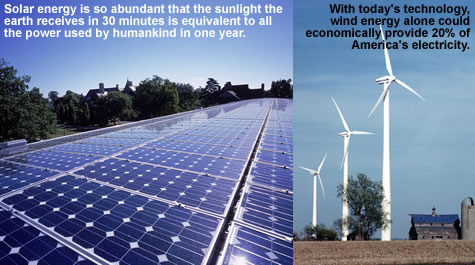
 |
| Home > Policy Issues > Renewable Energy Incentives > Introduction | ||
IntroductionBetween 1970 and 1998, global energy use rose by about 70%, and demand for energy continues to rise at a rate of about 2% each year.(1) While energy use and resource extraction fuel the global economy and development worldwide, they pose serious environmental hazards. Increases in conventional energy use mean parallel increases in emissions, including greenhouse gasses, which mean more smog, more global warming effects, and more risks to human and environmental health. Renewable energy can reduce our dependence on fossil fuels, reduce the harmful pollution currently associated with energy production and consumption, and reduce our emissions of greenhouse gases. Alternative heating and cooling systems that run on non-traditional, renewable energy sources and produce fewer harmful emissions can substantially reduce consumers’ energy costs. Geothermal heat pump systems can reduce energy consumption by 25-75%.(2) Photovoltaics and other solar energy systems don’t use fossil fuels and produce no greenhouse gases; in fact, they produce no atmospheric emissions.(3) The promotion of these types of alternative fuel energy systems helps to decrease our dependence on finite energy sources and the environmental degradation that accompanies extraction and transportation. |
||
|
||
However, when compared to traditional sources of energy, most renewables are still in the relatively early stages of technological development and have very different cost structures, with high up-front costs and low operating costs. That is why financial incentives for the manufacture, purchase, and installation of alternative systems are so critical to meeting the nation’s long-term energy needs in a sustainable and responsible way. To help these technologies develop and the markets adapt to changes, both federal and state governments have offered a variety of tax incentives for the manufacture, installation, and use of renewable energy systems. This package focuses on ways to maximize the impacts of these incentives. SERC’s package on renewable energy incentives is designed to introduce you to the different types of incentives that you can implement in your state. These include several types of tax incentives (income, property, sales) for individuals and businesses that manufacture or purchase renewable energy systems. The background, talking points, and fact pack sections will help you understand how and why such incentives make environmental and economic sense for your state. In lieu of a sample bill, SERC has included a thorough sampling of different strategies that states can use to encourage the development and use of renewable energy. Not all of these tax provisions will be appropriate for all states, but many hold significant potential for altering individual and business behavior in a manner consistent with environmental values. By providing incentives for renewable energy projects, states can reduce pollution, encourage technological development, and improve economic growth. This web site offers the tools necessary to introduce and pass legislation to encourage the use of renewable energy in your state. These tools include examples of effective state legislation, talking points, press clips, a fact pack, links, and other background information. We may have other useful materials on this subject which are not posted on our web site. Please feel free to contact us at info@serconline.org or call our office in Madison, Wisconsin, at (608) 252-9800. If you’ve used this site and found it helpful, or if you have suggestions about how it could be made more helpful, please let us know. |
||
| Sources: (1) “Power Surge: Energy Use and Emissions Continue to Rise.” World Resources. 1998-1999. 4 August 2004 <http://www.wri.org/wr-98-99/emission.htm>. (2) “Geothermal Heat Pumps.” U.S. Department of Energy, Energy Efficiency and Renewable Energy. Content last updated 2 April 2004. 4 August 2004 <http://www.eere.energy.gov/consumerinfo/factsheets/geo_heatpumps.html>. (3) “Photovoltaics.” Energy Center of Wisconsin. 4 August 2004 <http://www.ecw.org/ecw/infopackagedetail.jsp?infoPackageId=11>. |
||
| This page was last updated on August 4, 2004. |
